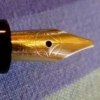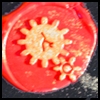Search the Community
Showing results for tags 'indigo'.
-
TAG Kyoto - kyo-iro - Soft Snow of Ohara TAG is a stationary shop in Kyoto (Japan) that produces some interesting soft watercolour-style inks. With the kyo-iro series they produce a line of inks that that are inspired by the city's many beautiful and historic sights. Each of these inks i...
- 28 replies
-
Background Here is a short review (and lots of pictures) of the Wancher Japan Blue limited edition fountain pen. This is a Wancher pen with Sailor base. TLDR - it is a beautiful made, striking pen whcih writes like a Sailor pro gear slim/1911 Std but feels more substantial (in a positive way) in...
-
Hello again to all my FPN friends, I happened to have 2 pens of similar flow and nib size inked with these and thought it might be helpful to compare them. Both are iron-gall inks and somewhat similar in color. However, at least in my experience, Hero 232 is much drier than Pelikan 4001 Blue-Black...
-

Fountain Pen Revolution "himalaya"--Hard To Beat At This Price
writerstephen posted a topic in Fountain Pen Reviews
A while back, I purchased a fountain pen called the Indus from Fountain Pen Revolution. With that pen, you get an integrated, piston-filler (capable of full disassembly) with a very smooth steel nib with ebonite feed. However, that pen had some quirks (like a wiggly clip, a weird smell, and a very s...- 75 replies
-
Hey all you ink lovers, My wife is a big, big fan of purple. Even our wedding had lots of purple accents in it. But, personally, I've never thought too much about the color. Until, I got into fountain pens. And furthermore, until I recently chowed down on an ube. Allow me to explain: the Filipin...
-
A rich blue-indigo ink made by sailor for a shop located in Tokyo. http://i.imgur.com/IxVROmv.jpg http://i.imgur.com/wsq3ONE.jpg Close-ups on Graphilo paper http://i.imgur.com/fmbxYl8.jpg http://i.imgur.com/yFcB7qI.jpg http://i.imgur.com/iIXJqUV.jpg On Tomoe. I didn't really have anyth...
- 13 replies
-
- sailor
- shousaikan
-
(and 2 more)
Tagged with:
-
Well, I feel a little bad about posting a review of an ink that is most likely unobtanium. A sample was sent to me early last year, and I've only now gotten to actually trying the ink. It was apparently a Noodler's custom ink for perhaps a Swedish Pen Club. I don't remember the exact circumstances s...
-
Yesterday I posted a quick look at De Atramentis' Atlantic Blue. Here's the other ink I picked up - Indigo Blue. Photo http://i200.photobucket.com/albums/aa163/roomdog/Ink/DeAtramentisIndigoBluePhoto_zps71d44c50.jpg Photo Cropped http://i200.photobucket.com/albums/aa163/roomdog/Ink/f0142b44...
- 1 reply
-
- de atramentis
- blue
-
(and 2 more)
Tagged with:
-
http://yoonhalee.com/images-inks/diamine-indigo.png











